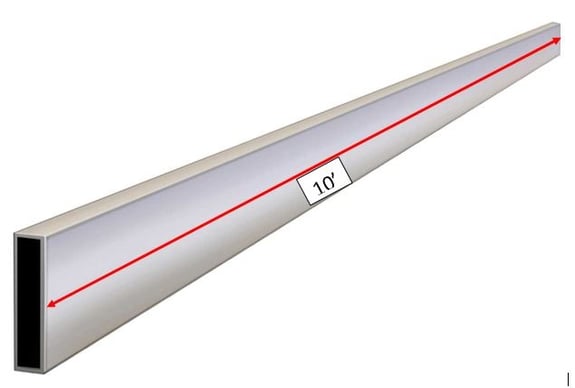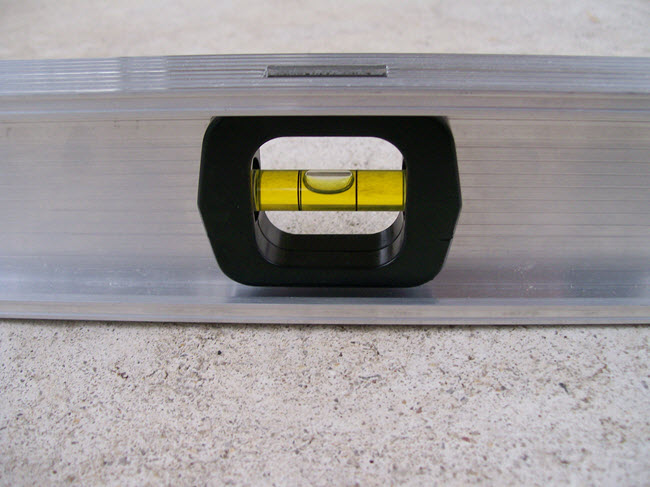
Does the word flat have the same meaning as the word level when it comes to floors and, more importantly, tile installation? If we look in various dictionaries, flat and level can have almost the same definition which can be confusing.

Furthermore, you'll find the terms used interchangeably when you search online, visit tile DIY forums, and even in conversation. This is particularly concerning when in tile work these two words are drastically different and, as you will see, the difference in their meanings can be very expensive.
Here's how 'flat floor' and 'level floor' are different.
Flat means no significant high or low spots
In the tile world, the word “flat” means that the surface does not have any significant high or low spots and will yield a smooth tile installation with no lippage between tile edges. But how do we determine if the floor is flat enough and what is used to make this determination?
In the tile industry, this tool is known as the ten-foot straight edge which is usually fabricated of magnesium or aluminum. It can be an “L” shape or a rectangular box as shown below.

The 10’ straight edge is used in all tile industry requirements to determine flatness. ANSI A108.02 – 4.1.4.3.1 states,
“For tiles with all edges shorter than 15” (0.38 mm), the maximum allowable variation is no more than 1/4” in 10’ (6 mm in 3 m) and no more than1/16” in 1’ (1.6 mm in 0.3 m) from the required plane, when measured from the high points in the surface.
For tile with at least one edge 15” (0.38 mm) or longer, the maximum allowable variation is no more than 1/8” in 10’ (3 mm in 3 m) and no more than 1/16” in 2’ (1.6 mm in 0.6 m) from the required plane, when measured from the high points in the surface.”
If the surface is less flat than required, it must be either ground down (using the appropriate dust-capturing tools and OSHA-approved methods), built up with the proper patch material, or a combination of the two. Additionally, a self-leveling underlayment (SLU) can be placed over a properly prepared surface that has been coated with the manufacturer’s approved primer.
>> See The Ultimate Guide to Underlayment for TileA level floor means it is parallel to the horizon
On the other hand, the word “level” has a much different meaning in relation to tile work. A level surface needs to be parallel to its perfectly horizontal plane.
If the tile installation is required to be level by the architect or owner, it must place the bubble of spirit level between the lines as shown in the photo below, otherwise, the surface is considered to be “out of level.”

In order to determine if the substrate meets the required level plane, we again use the 10’ straight edge with the spirit level placed on top of the straight edge.
The perils of not knowing flat from level
Here is a true story of a tile contractor who didn’t realize there was a significant difference between flat and level.
The job he was doing had a large concrete floor which was in terrible shape. He told the architect that he would “level” the floor for a specified amount of money. The change order was approved and the work was completed with a cementitious floor patch which made it suitable to receive tile (i.e., it was flat).
When floor "leveling" had been completed, the architect came to the job with a four-foot level in hand. He promptly placed it on the floor and you guessed it, the floor was not level.
The tile installer said, “I meant flat.” But the architect reminded him that he had signed the change order for level.
The installer was forced to have a specialized floor preparation company come in and pump enough self-leveling underlayment (SLU) over the recently "flattened" floor at a cost of over $50,000.
This was an extremely expensive mistake, but this contractor now knows the difference between the words flat and level.
Making a surface level and flat...
If the surface is required to be flat and level, the use of the products mentioned above can, when properly installed, provide a surface that is both flat and level.
As tile installers, we must have a flat surface to install large format tile and level is even better.
>> See Is Your Floor or Wall Flat Enough for Large Format Tile?
Know the difference between flat and level!
The next time you are called on to fix a bad floor, be absolutely certain you know whether you are providing a flat surface or a level surface. Level can be much more expensive than flat. Make sure you know the difference.
If you haven't already, consider becoming a Certified Tile Installer (CTI). As a CTI, you set yourself apart from the crowd and know how to anticipate tile installation problems before they occur.
>> See The Tile Installation Experience with Scott Carothers at Coverings.
Do it right the first time and get paid accordingly.
Thanks for reading.
Scott
Note: We originally published this article on 10/31/2017, and have updated it.

